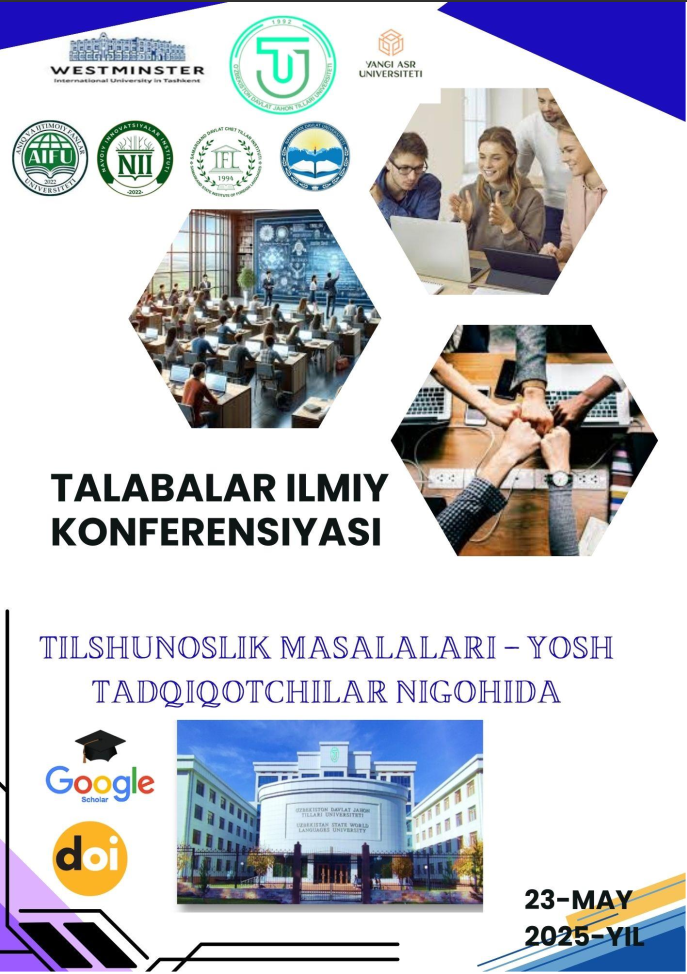THE LINGUOCULTURAL DIMENSION OF LACUNAE IN ENGLISH AND UZBEK NARRATIVES
https://doi.org/10.5281/zenodo.15517475
Kalit so‘zlar
Lacunae, linguoculture, cultural gaps, English literature, Uzbek literature, translation challenges, intercultural communication, literary equivalence, cultural semantics, untranslatability, linguistic relativity, narrative analysis, national identity, cross-cultural understanding.Annotasiya
This article explores the linguocultural dimension of lacunae conceptual or lexical gaps in English and Uzbek narratives, shedding light on the challenges and opportunities these cultural voids present in literary analysis and translation. Lacunae, by their very nature, are deeply embedded in a culture’s worldview, values, and communicative norms. As such, they often resist direct equivalence across languages, particularly in literature, where meaning is not only linguistic but also symbolic, contextual, and emotional.
The study begins by defining the concept of "lacuna" in both linguistic and cultural terms and outlines its relevance in comparative literature and intercultural communication. Drawing upon a corpus of English and Uzbek literary texts including works by authors such as William Faulkner, George Orwell, Abdulla Qodiriy, and Chingiz Aitmatov the article examines specific instances of cultural lacunae. These include terms, expressions, and cultural references that are difficult to translate due to the absence of analogous concepts in the target culture. The analysis further investigates how such gaps reflect national identities, social norms, and historical experiences unique to each linguistic community.
In addressing the challenges lacunae pose for translators and literary scholars, the article proposes several strategies for managing them, including functional equivalence, explicative translation, and the use of footnotes. Moreover, it underscores the importance of cultural competence in bridging these linguistic divides and fostering deeper intercultural understanding.
Ultimately, the article concludes that lacunae are not simply obstacles but are, in fact, key indicators of cultural richness and diversity. Recognizing and interpreting these gaps enhances the appreciation of both English and Uzbek narratives and opens pathways to more nuanced literary dialogue across cultures.
Foydalanilgan adabiyotlar ro‘yhati
Alimdjanovna, K. M. (2024). ADVANTAGES OF SCAFFOLDING IN TEACHING READING COMPREHENSION. Eurasian Journal of Social Sciences, Philosophy and Culture, 4(5-1), 163-166.
Alimova, D. (2024, October). Teaching English through English: Proficiency, Pedagogy and Performance. In Conference Proceedings: Fostering Your Research Spirit (pp. 779-782).
Gulomova, R. (2020). Sociolinguistic competence of L2 students. TJE-Tematics journal of Education ISSN, 2249-9822.
Kade, Otto. (1968). The Practice of Translation. New York: Cambridge University Press.
Kholbutayeva, S., & Gulshoda, R. (2025). PEDAGOGICAL INNOVATIONS: HOW TO ENHANCE STUDENT ENGAGEMENT THROUGH KAHOOT?. YANGI O ‘ZBEKISTON, YANGI TADQIQOTLAR JURNALI, 2(7), 141-145.
Larson, Mildred L. (1984). Meaning-based Translation: A Guide to Cross-language Equivalence. Lanham, MD: University Press of America.
LOST IN TRANSLATION: HOW SOCIAL MEDIA SLANG SHAPES GLOBAL COMMUNICATION. (2024). Western European Journal of Linguistics and Education, 2(6), 185-189.
Mukhtashamova, P. Z. (2019). DISTINCTIVE FEATURES OF ENGLISH LANGUAGE. Экономика и социум, (3 (58)), 50-51.
Nida, Eugene A. (1964). Toward a Science of Translating: With Special Reference to Principles and Procedures Involved in Bible Translating. Leiden: Brill.
Sapir, Edward. (1921). Language: An Introduction to the Study of Speech. New York: Harcourt, Brace & World.

